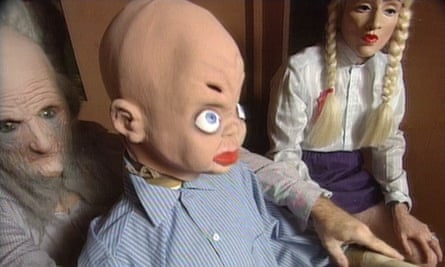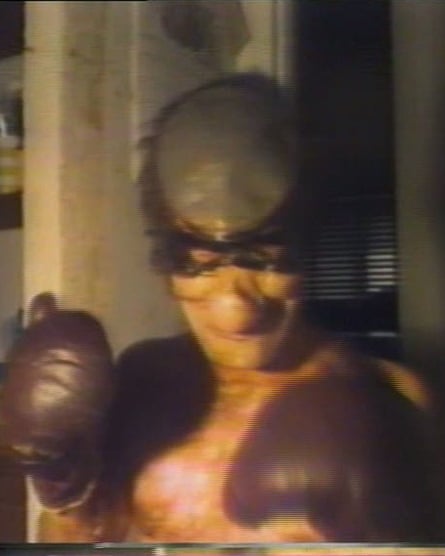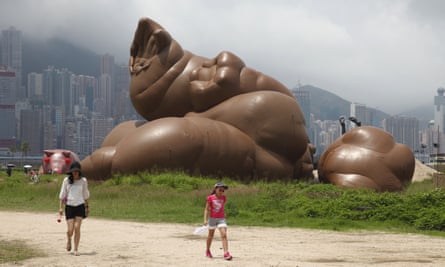Paul McCarthy’s vision of modern America is relentlessly revolting. His art depicts his nation as a crumbling edifice of pop culture, creeping fascism and depraved, uninhibited capitalism. “It’s always been this thing of looking at the underbelly of western culture, and the horror of its results,” he says over Zoom from his home in Los Angeles. “It’s a questioning of our condition, our way of life. Look at America right now with its racism and its violence, and yet we have Disneyland.” His art, he says, is “trying to expose that – the posing of the purity and the innocence”.
Some of this work has been on a grand scale. In 2013, for the work Rebel Dabble Babble, McCarthy built two derelict houses in a dark, grim New York warehouse. Each one was filled with screens showing James Dean and the cast of Rebel Without a Cause engaged in brutal, close-up, hardcore pornography. A man in a long coat followed me around the show on my visit – the stereotypical flashing pervert, hands stuffed into his pockets, sweating and mumbling to himself. It wasn’t clear if he was part of the show or just a very excited gallerygoer, but it all contributed to the exhibition’s visceral unease. It was quintessential McCarthy.
Now, the 74-year-old is returning to Switzerland – the country where 12 years ago he caused a sensation by exhibiting a giant inflatable turd that came untethered, brought down a power line and landed in the playground of a children’s home – for an exhibition of works from throughout his career titled Alpine Stories and Other Dystopias. He was born more than 5,000 miles away, in Salt Lake City, but Switzerland has been a lifelong obsession. “At quite an early age I was interested in mountaineering,” he says. “I think it had a lot to do with wanting to leave where I was. When I was in high school, I wanted to be a Swiss mountain guide, which was a pretty rare choice of occupation in Utah. It was about bohemian lifestyles, about somehow leaving these conventions of normality.”

But McCarthy didn’t simply leave those conventions, he dedicated his life to exposing their decrepitude. If Switzerland represents a faraway ideal for American dreamers, McCarthy’s remake of the Alpine-themed Shirley Temple movie Heidi (created with with fellow artist Mike Kelley in 1992) set out to mock and denigrate Hollywood’s vision of a beautiful European escape. “The other subject that began to come up at that time for me was fascism. So this combination of the Alps, lederhosen, father figures, the Matterhorn, the Disneyland aesthetic, fascism and America all becomes a big stew.” A stew where the idealism of America and Hollywood is boiled until evil rises like scum to the surface.
Due to problems with shipping art during the pandemic, the Swiss exhibition at Tarmak 22 in Gstaad features no new work, only pieces that were already in storage in Switzerland when coronavirus hit. “It’s a kind of smorgasbord,” McCarthy says. Now an art world that McCarthy says is usually “moving like a steam shovel” has been stilled, the pandemic has offered a rare chance to look back over older work. “Meanings change, you see things differently, you see connections, threads that weave through things.” The threads of violence and fascism, and the constant questioning of the state of things, appear again and again in his work, each new decade bringing fresh and relevant perspectives on old tropes.

McCarthy left Utah in the early 70s to study fine art in California. Ever since, his complex and often utterly gross art has been headline-grabbing stuff. There was that rampant inflatable turd (Complex Shit, 2008) in Switzerland, his enormous buttplug balloon (Tree, 2014) in Paris, which was deflated by a protester; he’s created animatronic rubber sculptures of George W Bush having sex with a pig, and drawings of Snow White and her seven dwarves defecating on each other.
These days McCarthy is a well-respected art-world figure, with big museum shows and a major gallery representing him. But it took him a while to get there. He didn’t even sell any art until the early 90s. Before then, he’d been busy making a name for himself as the leading light of ultra-challenging American performance art, armed only with vomit, ketchup, masks and nudity – as in his 1976 film Rocky, which was on display in the early days of Tate Modern. It showed McCarthy dressed as the boxer, punching himself repeatedly in the head, pouring ketchup over his genitals, masturbating and muttering to himself. It’s relentless, violent, traumatic.
When asked if America still needs exposing in 2020, a time when the country’s nastier sides are more apparent than ever, McCarthy’s tone switches from considered drawl to something closer to what you’d expect from a man who made a career out of rubbing ketchup into his orifices. “How much more absurd can you get than Donald Trump? It’s a really good example of a performance, it’s theatre. He’s really just manipulating a population. The idea that we could go, ‘Hey, we don’t need this any more, let’s just make images of utopia, of where we want to go …’” His voice trails off. He considers the idea silently for a minute, then his thoughts bubble over.

“That’s your head in the sand. Maybe I don’t have a choice but to throw up. We’re still trying to figure out what the fuck’s going on. Even now. Like, what is going on? We’re so utterly fucked up that, if anything, we really do need these experiments into this reality.” He’s not sure if he’s going to make work about Trump yet, but you wouldn’t be surprised if he did.
That’s the point of McCarthy’s art, be it film, sculpture, drawing, installation: to figure what is going on around you. There are no conclusions, no hard facts, just questions and experiments. But to do it the way McCarthy has always done it – with sex, violence, bodily fluids and sick humour – is a tricky thing in 2020. Does he ever worry about “cancel culture”, the threat of an online backlash? “When you refer to cancel culture, I don’t really know what that means any more,” he says with the weariness of a man who has spent his adult life being told he can’t make the art he’s trying to make. “But in the past few years I’ve been stopped a number of times, censored. I don’t know, four, five times a year.” He won’t be drawn on specific instances.

That censorship may have increased as the world has grown more conservative, but it’s something he’s always taken in his stride. “I’ve always had this view that making risky art was just really risky. You don’t know what it’s saying, it sits on an edge. At times I’ve made work where I’ve gone, ‘What the hell, are you really sure that’s what you want to do?’”
Few artists today do performances as in-your-face as his 70s works such as Class Fool, where he stuffed a Barbie doll up his backside and vomited over a ketchup-covered classroom. Few artists today are making installations as shocking or ambitious as Rebel Dabble Babble. It’s a testament to how hard he pushes things that, 40 years into his career, he’s still one of the most confrontational, shocking and jaw-droppingly weird artists you’ll encounter.
The most striking thing of all is that his disgusting visions of modern life don’t seem all that far removed from reality. Whereas once you could look at what he did as extreme, now, the more you take in his violence and anger, the more you realise that the world has slowly transformed into a big Paul McCarthy artwork. It’s the greatest Hollywood twist of all: here you are, wading through the faeces thinking it’s just a nightmare, but actually you were awake the whole time. “We’re really in a much more confused state than we’ve ever been,” he says.
It’s not McCarthy who’s weird and gross, it’s the world itself. Real life has just finally caught up with him – and that should seriously worry us all.
